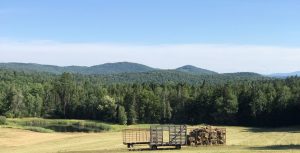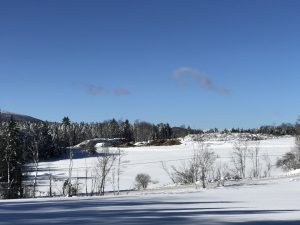Bruce and Doreen Jones: Multi-Purpose Parcel
Bruce and Doreen Jones are the owners of 260 acres in Rochester, VT. They purchased the property a few years ago after moving back to Vermont from California. Since then, the couple has been busy managing their land in different ways to keep it both productive and wild.
Bruce and Doreen both lived in Vermont previously, however Doreen’s work moved the pair to California in the late 1990s. Doreen explained they had always desired to own a woodland saying they wanted a property that “we could manage [on our own].” This love of and desire for woodlands was fostered further during their time out west through their volunteer work with the National Park Service and other public lands groups. After over 20 years in California Bruce and Doreen sought a change of pace. They grew tired of the crowded west coast and missed the changes in seasons that they were accustomed to living in the Northeast, so they took the opportunity to move back to Vermont in 2018.
Their property has different uses which they would like to maintain and improve through their management. All 260 acres are enrolled in Vermont’s Current Use program. Approximately 50 acres of the property are meadows, which a local grass-fed beef farmer hays. There is a recreational component to their property too as bike and snowmobile trails from a local trails group cross through parts of their property. In addition to these the Joneses want to keep the woodlands suitable as wildlife habitat. Part of the challenge with their parcel is balancing these varied uses of the land. They work to keep the land viable for grazing and for wildlife, while also encouraging those who may want to use the trails.
This past winter Bruce and Doreen did a significant logging project as part of their forest management. Bruce stated that they “took a big swing” in taking on the project. Working with a forester they were able to clear-cut areas, which will allow for expansion of pasture and regenerative growth for the forest. The project is not quite finished yet as stump removal and a re-seeding of the area still need to be done, but both have been satisfied with the work so far.
The whole process has been a learning experience for both Bruce and Doreen. They learned for the first time about the equipment and techniques involved in logging. Bruce was particularly encouraged by their logger’s concern for environmental impact. He shared that while it is a business for them, they do want to log in an environmentally friendly way. Doreen was impressed with how the forester and logger really examined all facets of their property and all angles of the project.
The Joneses have described their time owning the property as a learning experience. Apart from the logging, they have had to learn more about management, forest health, Current Use, and other aspects of forestry in caring for their land. Doreen spoke of fighting invasive species as another new challenge. She mentioned chervil and barberry as two invasives that are common on their property. They have had to learn how to remove them with minimal or no use of herbicides which takes a good deal of time and energy to do. Finding the time to do this work and figuring out how to best balance the different uses of the land is a constant learning process.
Bruce and Doreen are grateful for the VWA and other forestry groups for the guidance they have provided. The couple joined the VWA in 2018 and have found them to be a key resource in their work. They enjoy the newsletter, which provides information and updates for them. They also take advantage of the various programs and events VWA offers, such as a logging event they attended in Northfield once which they found beneficial.
Looking ahead Bruce and Doreen do not have many long-term goals for their land yet. For the time being they are focused on finishing the logging work done this winter and getting to the reforesting and seeding portion of the project. They plan to keep monitoring wildlife to determine who lives in their woods and encourage more habitation. However, they mainly want to keep finding the balance of their land. They want to continue learning how to maintain its pastoral functions, promote its “wild” features for the animals that inhabit it, and keep it usable for the people on its trails.





